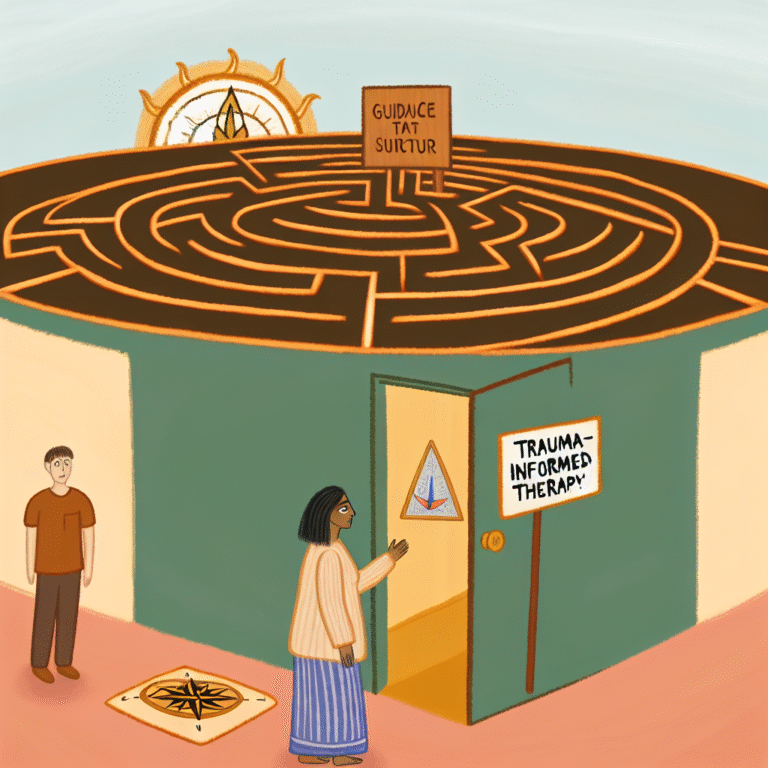
Searching for Safety: Essential Qualities to Look for in a Trauma-Informed Therapist
Introduction
In a world where trauma can touch anyone, the quest for healing becomes paramount. Whether it stems from childhood experiences, personal loss, or systemic injustices, trauma fundamentally alters how individuals perceive safety and connection. Thus, searching for safety through the therapeutic process becomes not just important but transformational. To truly benefit from this journey, one must intentionally seek out trauma-informed therapists equipped with specific, essential qualities. This article will guide you through the indispensable traits to look for, breaking down how these qualities create an environment of trust and healing.
Understanding Trauma-Informed Care
Before diving into the specific attributes of a suitable therapist, it’s crucial to understand what trauma-informed care entails. At its essence, trauma-informed care recognizes the widespread impact of trauma and emphasizes the importance of safety, choice, and empowerment. It shifts the focus from "What’s wrong with you?" to "What happened to you?"—thereby fostering an understanding of how trauma influences behavior and mental health.
The Four Pillars of Trauma-Informed Care
To fully grasp the framework for evaluating a trauma-informed therapist, it’s helpful to familiarize yourself with the four guiding principles of trauma-informed care:
- Safety: Creating an environment where clients feel physically and emotionally safe.
- Trustworthiness: Building trust through transparency and consistent boundaries.
- Choice: Supporting clients in understanding their options and empowering them to make decisions.
- Collaboration: Establishing a partnership where the therapist and client work together as equals.
Case Study: Sarah’s Journey
Sarah, a 32-year-old survivor of childhood abuse, illustrates the profound importance of selecting a trauma-informed therapist. When Sarah first sought therapy, she felt anxious and frightened, unsure of how to voice her feelings. Her first therapist, although well-trained, failed to create a space where Sarah felt safe and understood. The experience was overwhelming, leaving her even more disconnected than before.
After switching to a therapist who exemplified trauma-informed care, Sarah found a space characterized by patience and understanding. Her new therapist utilized active listening, validated Sarah’s experiences, and ensured she felt safe during sessions.
This case underlines not only the importance of searching for safety in therapy but also the transformative nature of finding the right therapist.
Key Qualities to Look for in a Trauma-Informed Therapist
As you embark on your journey of searching for safety, here are the key qualities to look for in a trauma-informed therapist:
1. Empathy and Understanding
Empathy isn’t just a buzzword; it’s a vital cornerstone of effective trauma-informed care. A competent therapist will show a deep understanding of trauma and its psychological impacts. Look for a therapist who employs a compassionate approach, validating your feelings and experiences without judgment.
2. Strong Interpersonal Skills
Therapeutic relationships thrive on effective communication and interpersonal skills. A trauma-informed therapist should communicate clearly, listen actively, and create a welcoming atmosphere. Pay attention during initial consultations; the therapist’s ability to engage and understand your needs can significantly affect your comfort level.
3. Active Listening
Effective therapy is rooted in active listening. A trauma-informed therapist will make you feel heard and understood. They will reflect back what you share, ask clarifying questions, and encourage you to explore your emotions at your own pace. The quality of listening must extend beyond words to include non-verbal cues, ensuring that the client feels safe to express themselves freely.
4. Knowledge of Trauma
An essential quality of a trauma-informed therapist is their knowledge of trauma systems and theoretical approaches. They should be well-versed in trauma-related issues and stay updated with research-based practices. This understanding ensures that they tailor their approach based on trauma’s complexities, thus providing a more effective therapeutic experience.
5. Availability of Resources
Therapy is often just one piece of a larger puzzle. A well-connected trauma-informed therapist should be able to provide or recommend additional resources, such as support groups, workshops, and self-help techniques. This holistic approach allows clients to gain a broader perspective on their healing journey.
6. Flexibility in Therapy Approaches
Each individual’s journey through trauma is unique, so a flexible therapist who can adapt their approach is indispensable. They should be willing to incorporate various therapeutic modalities—such as Cognitive Behavioral Therapy (CBT), Somatic Experiencing, or Eye Movement Desensitization and Reprocessing (EMDR)—to address your specific needs effectively.
7. Boundaries and Professionalism
Healthy boundaries ensure a safe therapeutic space. A trauma-informed therapist must maintain professionalism while creating a comforting environment. They should clearly outline their policies around confidentiality, session structure, and communication, helping you feel secure and respected.
8. Cultural Competence
Understanding that trauma can manifest differently across various cultures and backgrounds is crucial for effective therapy. A trauma-informed therapist should possess cultural competence—this includes awareness of cultural differences in expressions of trauma and approaches to healing. This cultural sensitivity fosters inclusivity and deeper connections.
Case Study: Mark’s Experience
Mark, a military veteran struggling with PTSD, exemplifies the need for cultural competence in therapy. After a series of dismissive interactions with therapists who lacked an understanding of military culture and its complexities, Mark finally found a therapist who specialized in trauma-informed care. This professional took time to learn about Mark’s background, creating a tailored approach that honored his experiences. The transformation in Mark’s emotional state after this experience emphasizes the significance of cultural awareness in trauma-informed therapy.
The Importance of Safety in Therapy
Safety is paramount. Without it, clients may retreat, becoming less engaged in the therapeutic process. This retreat can lead to re-traumatization and hinder any potential for growth.
Creating a Safe Environment
Therapists play a pivotal role in establishing safety through:
- Welcoming Space: A therapist’s office should feel inviting and calm—think comfortable seating, soft lighting, and minimal distractions.
- Clear Communication: Clients should be informed about what to expect in sessions. Unclear boundaries can lead to confusion, stirring feelings of vulnerability.
- Emotional Safety: Therapists must ensure emotional safety by fostering a non-judgmental environment. This emotional forthrightness lays the groundwork for authentic dialogue.
Chart: Emotional Safety Indicators
| Indicator | Description |
|---|---|
| Non-judgmental Attitude | Acceptance of all feelings without criticism. |
| Respect for Boundaries | Understanding and adherence to client-determined limits. |
| Consistent Availability | A therapist who honors their commitments. |
Evaluating Potential Therapists
As you search for safety in therapy, consider these steps to evaluate potential trauma-informed therapists:
Research Credentials: Look for educational background, certifications, and specialized training in trauma-informed care.
Read Reviews: Seek out testimonials and reviews from previous clients to gauge their experiences.
Ask Questions: Don’t hesitate to ask prospective therapists about their approach to trauma. Ensure their responses resonate with your expectations.
- Trust Your Gut: Finally, intuition plays a significant role. Pay attention to how you feel after your initial consultation.
Conclusion: The Journey Ahead
Searching for safety through the lens of trauma-informed therapy is not merely about finding a therapist; it’s about embarking on a path toward healing and empowerment. By focusing on essential qualities like empathy, strong interpersonal skills, knowledge of trauma, and cultural competence, you can navigate your journey more effectively.
Trauma affects everyone differently, and the right therapist can make all the difference. As you take these steps, remember that healing is not a linear process; it’s a winding, evolving journey filled with growth and discovery. Embrace it, and recognize that you are worthy of finding a safe space where your story is valued.
FAQs
1. What is the difference between a regular therapist and a trauma-informed therapist?
A trauma-informed therapist specifically understands the effects of trauma and tailors their therapeutic approach to honor that knowledge. While both types of therapists can be effective, trauma-informed therapists prioritize creating a sense of safety and empowerment for those who have experienced trauma.
2. How can I ensure that a therapist is truly trauma-informed?
Investigate their training, certifications, and experience in trauma. During initial sessions, observe how they approach discussions around trauma, safety, and client empowerment.
3. I’ve had a negative therapy experience before. How can I overcome that fear?
Acknowledging your fears is the first step. Consider starting your journey by communicating your apprehensions to your new therapist. A supportive and trauma-informed therapist will work with you to create a reassuring and safe environment that acknowledges your past experiences.
4. Are there specific questions I should ask a therapist during the first visit?
Yes! Ask about their experience with trauma, their approach to therapy, and how they ensure a safe and respectful environment for their clients. You may also inquire about their methods for handling confidentiality and boundaries.
5. What should I do if I feel uncomfortable with my therapist?
Your comfort is paramount in the therapeutic process. If you feel uncomfortable, communicate those feelings to your therapist. If you still feel uneasy, consider finding a new therapist altogether. Remember, seeking safety is your right.
In conclusion, the journey toward healing from trauma is deeply personal, yet with the right support system – one characterized by trauma-informed care – a safer, more empowering path to recovery is within reach. The qualities of empathy, respect, knowledge, and the ability to create a safe therapeutic environment will set the foundation for transformative healing experiences. You deserve to find that safety.















